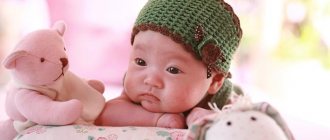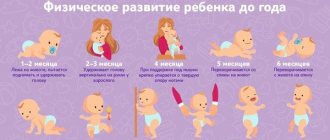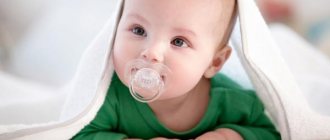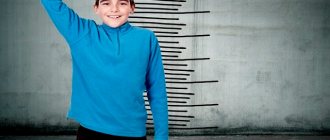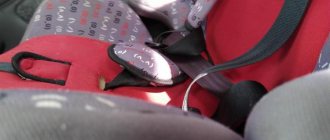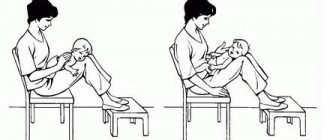The height and weight of a child are the main indicators of his physical development. That is why, immediately after the birth of the baby, they must measure his body weight and body length and continue to weigh himself every day at the same time until discharge from the hospital.
There are many factors that influence a child's physical development, for example:
- heredity (you shouldn’t expect short parents to have a son who is a basketball player)
- nutrition (it’s no secret that a deficiency of nutrients, vitamins and minerals slows down the growth and development of a child)
- physical activity (for example, playing tennis, volleyball, basketball helps increase height)
- child health (children with chronic diseases often lag behind their peers in physical development)
- psychological situation in the family, at school, lack of sleep, etc.
How to understand what is normal?
The All-Russian Health Organization recommends special tables for the height and weight of children, or, as they are called, centile tables. At each examination, the pediatrician measures the child’s height and weight and compares the obtained values with standard values. Such tables make it possible to identify obvious pathologies; for a more accurate analysis, the doctor calculates additional indicators using special formulas.
Table of weight and height of an infant by month (up to 1 year)
The table shows the average height and weight of infants (under 1 year of age) by month for boys and girls.
| Age | Girls | Boys | ||
| Weight, kg | Height, cm | Weight, kg | Height, kg | |
| Newborns | 3,33 ± 0,44 | 49,50 ± 1,63 | 3,53 ± 0,45 | 50,43 ± 1,89 |
| 1 month | 4,15 ± 0,54 | 53,51 ± 2,13 | 4,32 ± 0,64 | 54,53 ± 2,32 |
| 2 months | 5,01 ± 0,56 | 56,95 ± 2,18 | 5,29 ± 0,76 | 57,71 ± 2,48 |
| 3 months | 6,07 ± 0,58 | 60,25 ± 2,09 | 6,26 ± 0,72 | 61,30 ± 2,41 |
| 4 months | 6,55 ± 0,79 | 62,15 ± 2,49 | 6,87 ± 0,74 | 63,79 ± 2,68 |
| 5 months | 7,38 ± 0,96 | 63,98 ± 2,49 | 7,82 ± 0,80 | 66,92 ± 1,99 |
| 6 months | 7,97 ± 0,92 | 66,60 ± 2,44 | 8,77 ± 0,78 | 67,95 ± 2,21 |
| 7 months | 8,25 ± 0,95 | 67,44 ± 2,64 | 8,92 ± 1,11 | 69,56 ± 2,61 |
| 8 months | 8,35 ± 1,10 | 69,84 ± 2,07 | 9,46 ± 0,98 | 71,17 ± 2,24 |
| 9 months | 9,28 ± 1,01 | 70,69 ± 2,21 | 9,89 ± 1,18 | 72,84 ± 2,71 |
| 10 months | 9,52 ± 1,35 | 72,11 ± 2,86 | 10,35 ± 1,12 | 73,91 ± 2,65 |
| 11 months | 9,80 ± 0,80 | 73,60 ± 2,73 | 10,47 ± 0,98 | 74,90 ± 2,55 |
| 12 months | 10,04 ± 1,16 | 74,78 ± 2,54 | 10,66 ± 1,21 | 75,78 ± 2,79 |
Child development in the first year of life
02/22/2020 Reading time: 5 min 34246 0
Caring for the health and well-being of their child is natural for all parents. But mothers and fathers experience the greatest anxiety in the 1st year after the birth of the baby. During these 12 months, the child goes through a truly enormous journey from a helpless newborn to a child who is actively exploring the world around him and knows how to interact with it.
Each stage of this path has its own characteristics, and a table of child development by month, which shows the main indicators of height and weight, will help you understand them partly.
| Age (months) | Height (cm) | Body weight (kg) |
| Newborn | 49,0 – 54,0 | 2,6 – 4,01 |
| 1 | 52,0 – 55,0 | 3,0 – 4,3 |
| 2 | 55,0 – 57,0 | 4,5 – 5,0 |
| 3 | 58,0 – 60,0 | 4,0 – 6,0 |
| 4 | 60,0 – 63,0 | 4,5 – 6,5 |
| 5 | 63,0 – 67,0 | 6,5 – 7,5 |
| 6 | 65,0 – 69,0 | 7,5 – 7,8 |
| 7 | 67,0 – 71,0 | 8,0 – 8,8 |
| 8 | 71,0 – 72,0 | 8,4 – 9,4 |
| 9 | 72,0 – 73,0 | 9,4 – 10,0 |
| 10 | 73,0 – 74,0 | 9,6 – 10,5 |
| 11 | 74,0 – 75,0 | 10,0 – 11,0 |
| 12 | 75,0 – 76,0 | 10,5 – 11,5 |
The development of a child by month, or rather the basic physical parameters of growth and weight gain given in the table, can be classified as average, since they do not take into account the individual characteristics of the baby’s body. In any case, every month of life brings new achievements for the child!
1st month
At the age of one month, the baby already tries to raise his head for a few seconds when he is in a position on his stomach. Reacts well to loud sound and bright light. In response to loud and sharp sounds or bright light, the baby “defends himself” - he waves his arms and then presses them to his body.
2nd month
By holding your baby in your arms so that his body is in an upright position, you will see that he briefly tries or is able to hold his head. The child is no longer afraid of sounds and light, but tries to smoothly follow the object of interest to him. He tries to grab moving objects that are within his reach with his fingers, although this does not always work.
3rd month
Now the baby holds his head in an upright position. And in the position on his stomach, he is already able to lean on his elbows and try to lift his upper body. He makes attempts to roll over, grab the sheet, reach for toys, but his coordination is not yet very good, and not all attempts are successful.
4th month
At this age, the baby can already push off well with his feet when you hold him vertically. Toys evoke a strong emotional response in him. Having become interested, the baby raises his head and reaches for a bright object in an attempt to grab it.
5th month
The child rolls over from his back to his stomach and attempts to rise independently to take a sitting position. But he cannot stay in it for long. But he already firmly holds in his hand the object of interest to him and carefully studies it, distinguishes close people from strangers and begins to understand his mother’s emotions by the intonations in her voice.
6th month
The baby learned not just to sit, but to sit down on his own. He easily rolls over from his stomach to his back and vice versa. Taking the child by the hands, you can observe how he is already consciously, and not reflexively, trying to walk. He reaches for a fallen toy, and if he manages to get it, he picks it up without outside help.
7th month
This is the age when it is no longer enough for a baby to sit still. He is actively mastering crawling, and, leaning on furniture or other durable objects, he can stand. The baby is increasingly interested in the world around him. He recognizes objects well (especially his favorite ones), and studying his own reflection in the mirror becomes one of the most exciting activities.
8th month
At this age, a child can play with his favorite toys for a long time. You can play “Okay” with him. He shows a wide range of emotions - from fear to joy, and when holding the hands of mom or dad, he can confidently step his feet on the floor.
9th month
Now the baby not only knows how to stand up on his own and move around, leaning on furniture, he can even refuse the help of adults and try to do everything himself. But here it is important to take into account the peculiarities of the child’s development and not rush him to take his first independent steps.
10th month
This is the age when it is no longer enough for a baby to show emotions with facial expressions. Now he can do this with the help of monosyllabic words and hand movements. He perfectly imitates everything he sees and hears: his parents’ gestures, their intonation, their activities. Can engage in simple activities for a long time: open and close a dresser drawer or cabinet door, throw and pick up a toy, etc.
11th month
Communication skills have developed to the extent that the baby can express his agreement and disagreement, approval and disapproval with the correct gestures and facial expressions. Refusing something, he shakes his head and nods in agreement. He already knows what sounds animals make, and when asked to show something or do something, he usually readily agrees.
12th month
The child is interested in absolutely everything that happens around him: the noise of traffic outside the window, the movement of water while swimming, more complex toys. He knows how to perform difficult tasks expressed in words: upon request, he closes or opens the door, brings the necessary items from another room.
All babies are different, and if some of the skills described appear a little earlier or a little later, don’t worry or be upset! You can always ask your pediatrician about all the developmental features of your child.
(7 ratings; article rating 4.9)
Share Share Share
Table of child weight and height by year (from 1 to 18 years)
The table shows the average height and weight of a child by year from 1 to 18 years of age for boys and girls.
| Age | Girls | Boys | ||
| Weight, kg | Height, cm | Weight, kg | Height, kg | |
| 1 year 3 months | 10,52 ± 1,27 | 76,97 ± 3,00 | 11,40 ± 1,30 | 79,45 ± 3,56 |
| 1 year 6 months | 11,40 ± 1,12 | 80,80 ± 2,98 | 11,80 ± 1,18 | 81,73 ± 3,34 |
| 1 year 9 months | 12,27 ± 1,37 | 83,75 ± 3,57 | 12,67 ± 1,41 | 84,51 ± 2,85 |
| 2 years | 12,63 ± 1,76 | 86,13 ± 3,87 | 13,04 ± 1,23 | 88,27 ± 3,70 |
| 2 years 6 months | 13,93 ± 1,60 | 91,20 ± 4,28 | 13,96 ± 1,27 | 81,85 ± 3,78 |
| 3 years | 14,85 ± 1,53 | 97,27 ± 3,78 | 14,95 ± 1,68 | 95,72 ± 3,68 |
| 4 years | 16,02 ± 2,30 | 100,56 ± 5,76 | 17,14 ± 2,18 | 102,44 ± 4,74 |
| 5 years | 18,48 ± 2,44 | 109,00 ± 4,72 | 19,70 ± 3,02 | 110,40 ± 5,14 |
| 6 years | 21,34 ± 3,14 | 115,70 ± 4,32 | 21,9 ± 3,20 | 115,98 ± 5,51 |
| 7 years | 24,66 ± 4,08 | 123,60 ± 5,50 | 24,92 ± 4,44 | 123,88 ± 5,40 |
| 8 years | 27,48 ± 4,92 | 129,00 ± 5,48 | 27,86 ± 4,72 | 129,74 ± 5,70 |
| 9 years | 31,02 ± 5,92 | 136,96 ± 6,10 | 30,60 ± 5,86 | 134,64 ± 6,12 |
| 10 years | 34,32 ± 6,40 | 140,30 ± 6,30 | 33,76 ± 5,26 | 140,33 ± 5,60 |
| 11 years | 37,40 ± 7,06 | 144,58 ± 7,08 | 35,44 ± 6,64 | 143,38 ± 5,72 |
| 12 years | 44,05 ± 7,48 | 152,81 ± 7,01 | 41,25 ± 7,40 | 150,05 ± 6,40 |
| 13 years | 48,70 ± 9,16 | 156,85 ± 6,20 | 45,85 ± 8,26 | 156,65 ± 8,00 |
| 14 years | 51,32 ± 7,30 | 160,86 ± 6,36 | 51,18 ± 7,34 | 162,62 ± 7,34 |
| 15 years | 56,65 ± 9,85 | 161,80 ± 7,40 | 56,50 ± 13,50 | 168,10 ± 9,50 |
| 16 years | 58,00 ± 9,60 | 162,70 ± 7,50 | 62,40 ± 14,10 | 172,60 ± 9,40 |
| 17 years | 58,60 ± 9,40 | 163,10 ± 7,30 | 67,35 ± 12,75 | 176,30 ± 9,70 |
Measuring table for socks and booties for newborns
Just like bonnets, socks can sometimes be found with designations such as 0, 1-3, 3-6, 6-9 and so on.
- 0 – premature or very small babies, suitable for discharge from the maternity hospital. Size is approximately 8 cm;
- 1-3 – just born, about 10 cm;
- 3-6 – infants, over 13 weeks of age, approximately 12 cm;
- 6-9 – children up to six months old, 14 cm;
- 9-12 – for children from six months to one year, equal to 16 cm.
If you need to buy socks, but the length of your baby’s foot is unknown, then you should use the socks measurement table.
Socks:
| Age | Size |
| From birth to six months | 7-9 |
| From six months to a year | 10-12 |
| 1-3 years | 13-15 |
| 3-5 years | 16-18 |
When choosing socks “by eye”, choose products made of elastic fabric, which in case
When choosing socks “by eye”, choose products made of elastic fabric, which, if something happens, will stretch to a decent length, or vice versa, will sit on the leg.
With booties, things are different: it is advisable to know the exact measurements of the boy, this is due to the fact that booties are much larger than socks. But if you really had to choose blindly, you need to use a grid with measurements.
Booties:
| Age (months) | Foot length | Size (US) | Size (Europe) |
| Newborn | 9,5 | 0-2 | 16-17 |
| 3-6 months | 10,5 | 2,5-3,5 | 17-18 |
| 6-12 months | 11,7 | 4-4,5 | 19 |
| 12-18 months | 12,5 | 5-5,5 | 20 |
| 18-24 months | 13,4 | 6-6,5 | 21-22 |
| US size | 0,5 | 1 | 1,5 | 2 | 2,5 | 3 |
| Size, England | 0,5 | 1 | 1,5 | 2 | ||
| Foot length in cm | 8,3 | 8,9 | 9,2 | 9,5 | 10,2 | 10,5 |
Conclusion
To purchase the most comfortable things for your baby, you need to know the exact parameters of his height, weight, leg length, and head circumference. If the baby has not yet been born, you can rely on the results of an ultrasound examination. But even an ultrasound will not be able to tell you the exact indicators, so the right option would be not to purchase anything in advance; if you really want to buy something, you need to do this at a minimum, maximum for release from the maternity hospital.
When a child grows up, many parents look for a new thing for him on Aliexpress, we suggest finding out and comparing children's sizes US to Russian on Aliexpress.
If the baby is expected to be large, you should start shopping for a small wardrobe with 62. When shopping, keep a table of baby clothing measurements nearby, it will help you choose the right things for your baby.
© 2021 textiletrend.ru
Deviations of weight or height from table values
There is no need to panic if there is a minimal discrepancy with the indicated values in the table, and here’s why:
- First of all, tables of a child’s height and weight contain reference indicators , what the child’s weight and height should ideally be, without taking into account many other factors . Sometimes parents of premature babies mistakenly use a standard table for comparison, while there are special tables for assessing the development of children born prematurely.
- The rate of growth and weight gain is unique for each child . In the first year of life, children develop in leaps and bounds. For example, during the period of introducing complementary foods, the baby’s weight may not reach the “norm” due to adaptation to a new type of food, and not because of pathology.
This does not mean that deviations from the norm should be ignored , but it is better to regard them as a reason to pay attention and consult with a specialist in order to identify possible health problems, or make sure that there are none.
Size standards according to GOST
Domestic and European standards have differences in designating the size of children's things. The size, as a rule, is developed taking into account the recommendations of specialists.
According to Russian GOST, when determining the size of children's clothing, the key indicators are chest circumference and height.
Foreign size sizing is based on height and does not take into account chest circumference. Therefore, when choosing a wardrobe, be sure to pay attention to the country of manufacture in order to immediately understand the specifics of the size chart.

